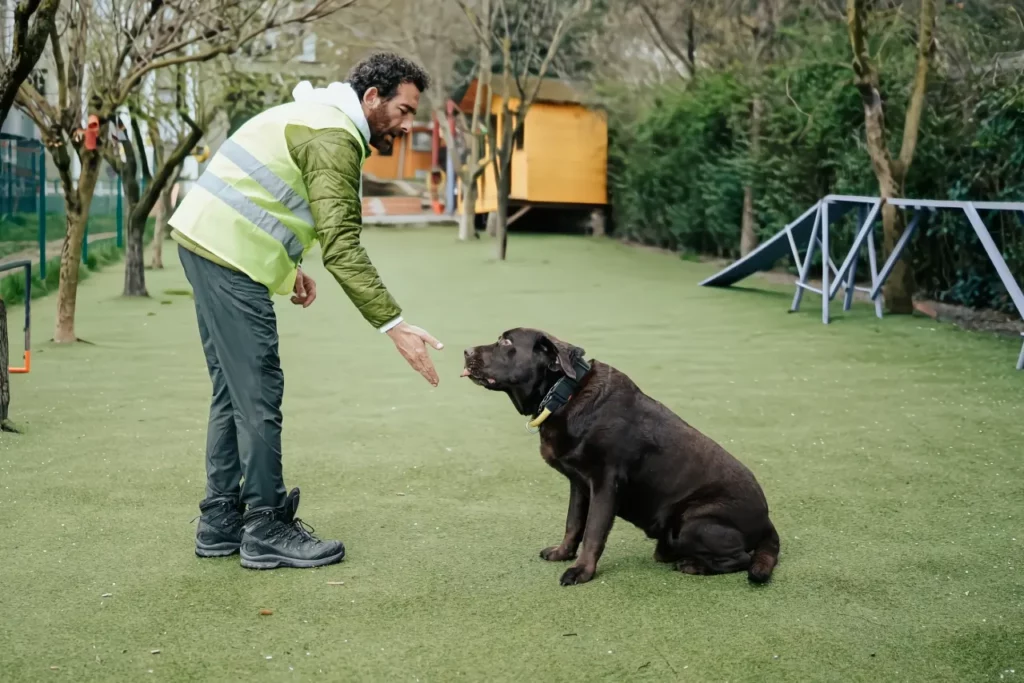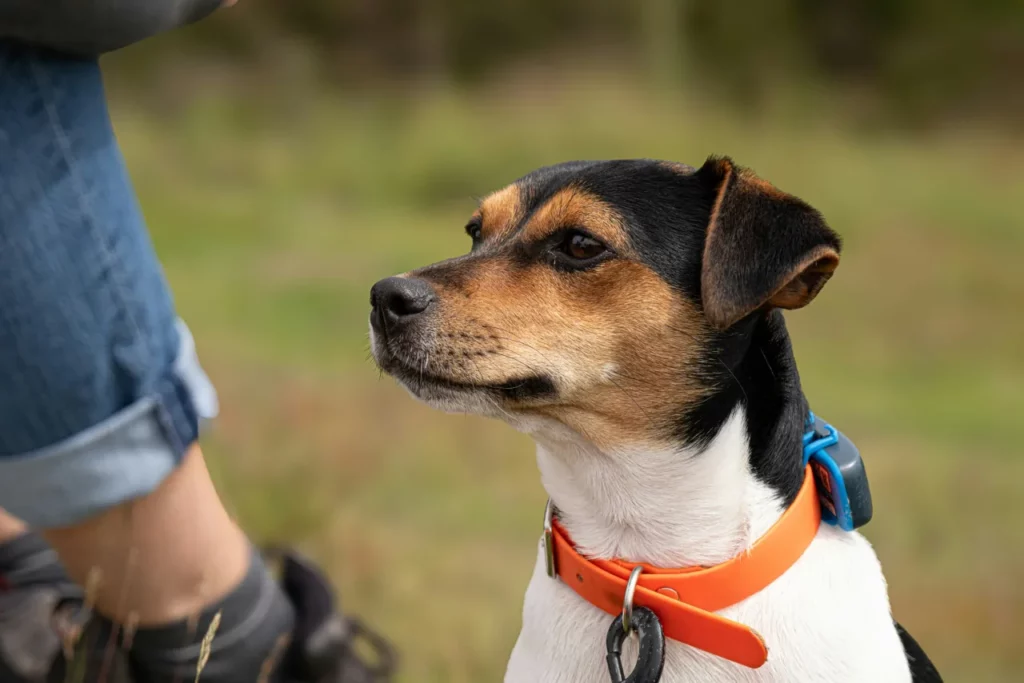You’ve probably heard the term before and maybe even seen one in action, but what is an e-collar for dogs, really? At Off Leash K9 Training Seattle, we help pet parents understand how this training tool works and why most dogs wear one comfortably and confidently during sessions. When used the right way, it helps reinforce good behavior and gives you a better way to communicate with your dog, even from a distance.
What Is a Dog E-Collar or Electronic Collar?
An e‑collar, or an electric training collar, looks like a normal dog collar but has a small pack that connects to a wireless remote. Depending on the model, that remote can reach anywhere from a few hundred feet to over a mile. You push a button, and the collar gives off instantaneous feedback in the form of either a beep or physical signals like a vibration or a very mild electrical sensation.
Many older versions just provided a sharp jolt. These days, collars allow you to set the level so low it’s more like a tap or gentle buzz, letting you grab your dog’s attention without causing any unnecessary pain.
How Does an E-Collar Work in Dog Training?

E-collars are used as an electronic training aid to help guide dogs toward desired behavior while gently correcting undesirable behaviors. When used correctly, often as part of a professional training method, these devices give a mild, adjustable stimulation that grabs your dog’s attention. Most modern e-collars include built-in safety features like tone or vibration modes and automatic shut-offs to make training safer and more effective.
Tone or Vibration, Stimulation, and Repetition
Most trainers start with tone-only or vibration mode. That tone acts like a remote “hey,” or a way to catch your dog’s attention from afar. If the dog responds to the tone, then there won’t be any need for stimulation. Over time, the dog begins to associate the tone with focus and follow-through.
If your dog doesn’t respond to the tone, trainers can then use a soft stimulation, sometimes called a “nick.” It’s not meant to hurt, but instead, it’s just supposed to snap your dog into focus. Trainers always begin training at the lowest possible level and increase only if absolutely necessary.
And of course, training includes lots of repetition. Trainers cue, tone, use continuous stimulation if needed, and reward compliance right away. Dogs learn that responding quickly means no stimulation or loud noise, plus a reward (treats or praise), which helps control undesired behavior.
Is E-Collar Training Safe for Dogs?

People often hear “e-collar” and immediately think of extreme pain or aversive tools, but those fears are usually based on the worst-case scenarios or misuse. In reality, most e-collars (especially modern ones) are built to avoid physical harm and can be incredibly safe when used properly. They deliver a gentle sensation to get your dog’s attention and help stop unwanted behavior in the moment.
That said, overuse or improper training can lead to increased stress and even an increased risk of fear-based reactions. That’s why any e-collar training should always be thoughtful, minimal, and temporary—not something you rely on for an extended period of time.
Different Types of E-Collars

E-collars come in different styles, and each one works a little differently depending on how it delivers stimulation to your dog’s body. Some use vibrations, others use tones or static stimulation to address bad behavior. Here’s what you need to know about the most common kinds out there.
- Tone-only collars: These collars just beep or vibrate and inflict no electric shock at all. This is ideal for dogs who respond well to sound cues.
- Low-level stimulation models: These are popular with modern trainers. You can set the buzz to very low, but most of the time, trainers aim for the dog to respond to tone alone. Stimulating is only a secondary option.
- GPS and boundary collars: Some remote training collars and high-end collars (like GPS-enabled Halo models) let you set invisible boundaries. Also called a receiver collar, they can beep or vibrate when your dog breaks boundary, alerting you before any stimulation. Usually, these are more about safety than discipline.
- Automatic shock/bark collars: These are dog training collars that administer shock automatically when crossing a boundary or to control nuisance barking. Trainers usually avoid these because they lack context. This doesn’t impact your dog’s behavior positively because they don’t learn cause and effect properly and can get scared by noises or triggers they can’t control.
Dog Shock Collars and Pinch Collars vs. E-Collars
Shock collars usually refer to older tools that deliver a high-intensity shock automatically, often with no warning. Many countries ban these altogether because they rely on pain, and they can be easily misused.
Pinch collars (also called prong collars) are worn around the dog’s neck and apply even pressure to the contact points when the leash is pulled. The design is meant to mimic how a mother dog might correct a pup: with a quick nip.
E‑collar is a broader, more accurate term. When used responsibly, many e‑collars don’t deliver pain; they offer warning tones or light vibrations. They are tools for communication, often with no shock ever used.
All in all, these three tools have very different effects on your dog’s behavior. Shock collars are largely discouraged, pinch collars need skilled handling, and e-collars, when used correctly, can be part of a balanced, modern training plan. No matter what tool you choose, your focus should always be on building trust and using any correction sparingly and responsibly.
Can Any Dog Use an E-Collar?

Not every pup can benefit from e-collars. A few things to consider:
- The dog’s personality: Shy, anxious, or sensitive dogs may not do well with even mild stimulation. Trainers would often go tone-only or skip the collar entirely. Calm, food-focused, confident dogs handle it better.
- Age and health: Most trainers don’t use e‑collars on small dogs or puppies under six months or those with heart or skin conditions. It’s safer and more effective to build behaviors with food, praise, and play instead.
- Training goals: If you want reliable recall in open spaces, an e‑collar can help, but only with careful training. For simple leash manners or basic obedience, reward-based methods often work just as well.
- Owner commitment: You have to learn proper timing and operation. If you aren’t consistent or misunderstand the tool, it’s more likely to be misused and cause harm than help.
Professional Guidance Matters in Handling E-Collars

Using an e-collar the right way takes more than just reading the manual. Instead, it’s something professional dog trainers are trained to guide you through. The collar has to fit snugly against your dog’s skin, not too loose or too tight, and it’s important to start slow, often with tone-only sessions before introducing any stimulation. One must know how to use the tool as part of a well-rounded obedience training plan. At Off Leash K9 Training Seattle, we also show you how to test the collar, watch for red marks or hesitation, and make sure no wire is exposed or pressing into the neck.
We start at the lowest stimulation level, gradually raise it only if needed, then slowly fade out the stimulation entirely. The goal is for the dog to obey with tone or verbal command alone. Throughout the process, we closely watch for signs of stress or discomfort, so if your dog shows fear, we pause.
The collar should never be used unsupervised or as a substitute for real training. That’s why we also focus on other methods, like reward-based cues, leash work, and impulse control. If the e-collar becomes unnecessary, we stop using it, because thoughtful, ethical training always comes first.
How We Use E-Collars at Off Leash K9 Training Seattle

Seattle gives us lots of environments, such as beaches, neighborhood roads, and trails. Used right, an e‑collar helps with control while giving your dog miles of freedom safely.
Real-World Scenarios
We’ve used collars for recall training in public parks when squirrels get chased, for boundary work in off-leash areas near busy streets, or when rehabilitating dogs that bolt unexpectedly.
Rewards Drive the Work
Every time the dog obeys, they receive treats, praises, and petting. That builds a positive association. Collar use becomes minimal over the weeks.
Stress Monitoring
We watch dog reactions, so if we see pinned ears, tail tucked, or lip licking repeatedly, we pause and adapt. We understand that every dog adjusts to e-collars differently.
We Help Dog Owners Use Dog Collars Safely and Effectively
Got a furry friend showcasing aggressive behavior, or a hunting dog who needs a little extra structure? The e-collars that come with our training packages are built with smart features like a wireless receiver and adjustable settings to fit your dog’s needs. And because we combine positive reinforcement training with expert-led behavior modification, you won’t have to worry about creating negative associations.
Take a look at our dog training prices and reach out to us directly if you have any questions.
